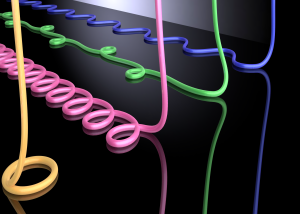Thin viscous fluid threads falling onto a moving belt behave in a way reminiscent of a sewing machine, generating a rich variety of periodic stitch-like patterns including meanders, W-patterns, alternating loops, and translated coiling. These patterns form to accommodate the difference be- tween the belt speed and the terminal velocity at which the falling thread strikes the belt. Using direct numerical simulations, we show that inertia is not required to produce the aforementioned patterns. We introduce a quasi-static geometrical model which captures the patterns, consisting of three coupled ODEs for the radial deflection, the orientation and the curvature of the path of the thread’s contact point with the belt. The geometrical model reproduces well the observed patterns and the order in which they appear as a function of the belt speed.
In the press:
Physics focushttp://physics.aps.org/synopsis-for/10.1103/PhysRevLett.114.174501
MIT News http://newsoffice.mit.edu/2015/predict-patterns-viscous-fluids-0423
Physics Buzz http://physicsbuzz.physicscentral.com/2015/03/cake-icing-and-climbing-ropes-physics.html

